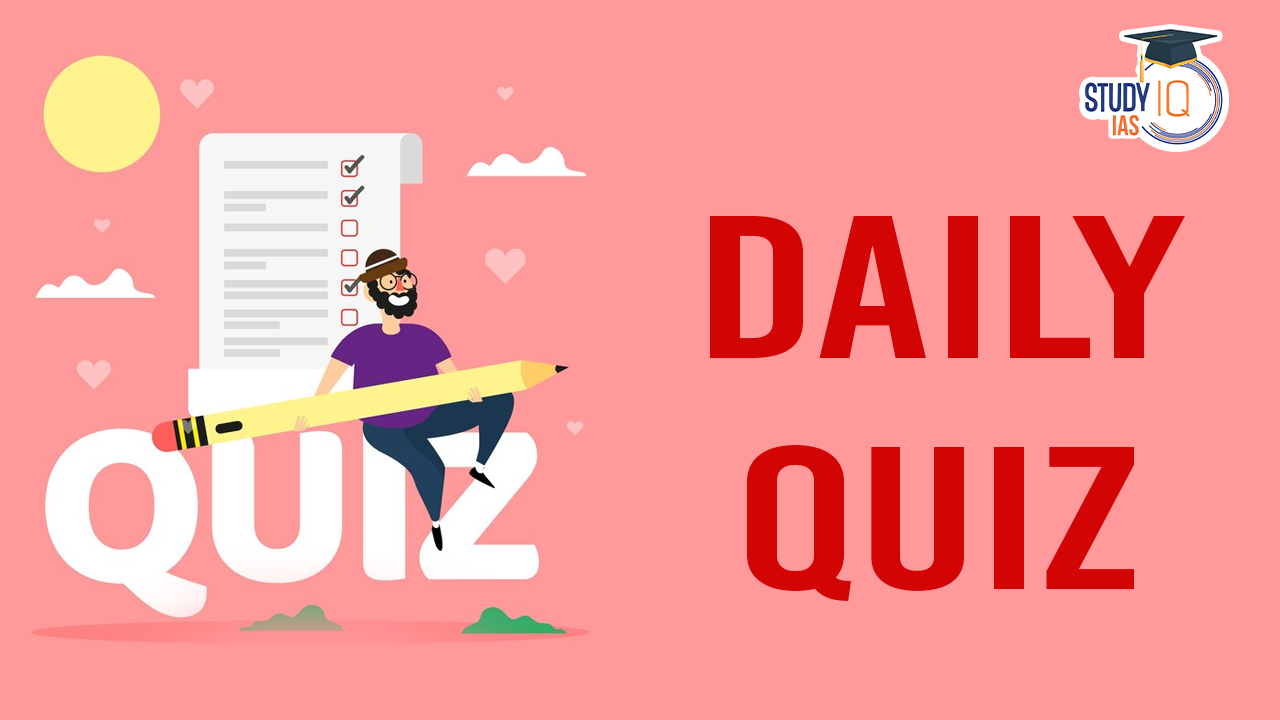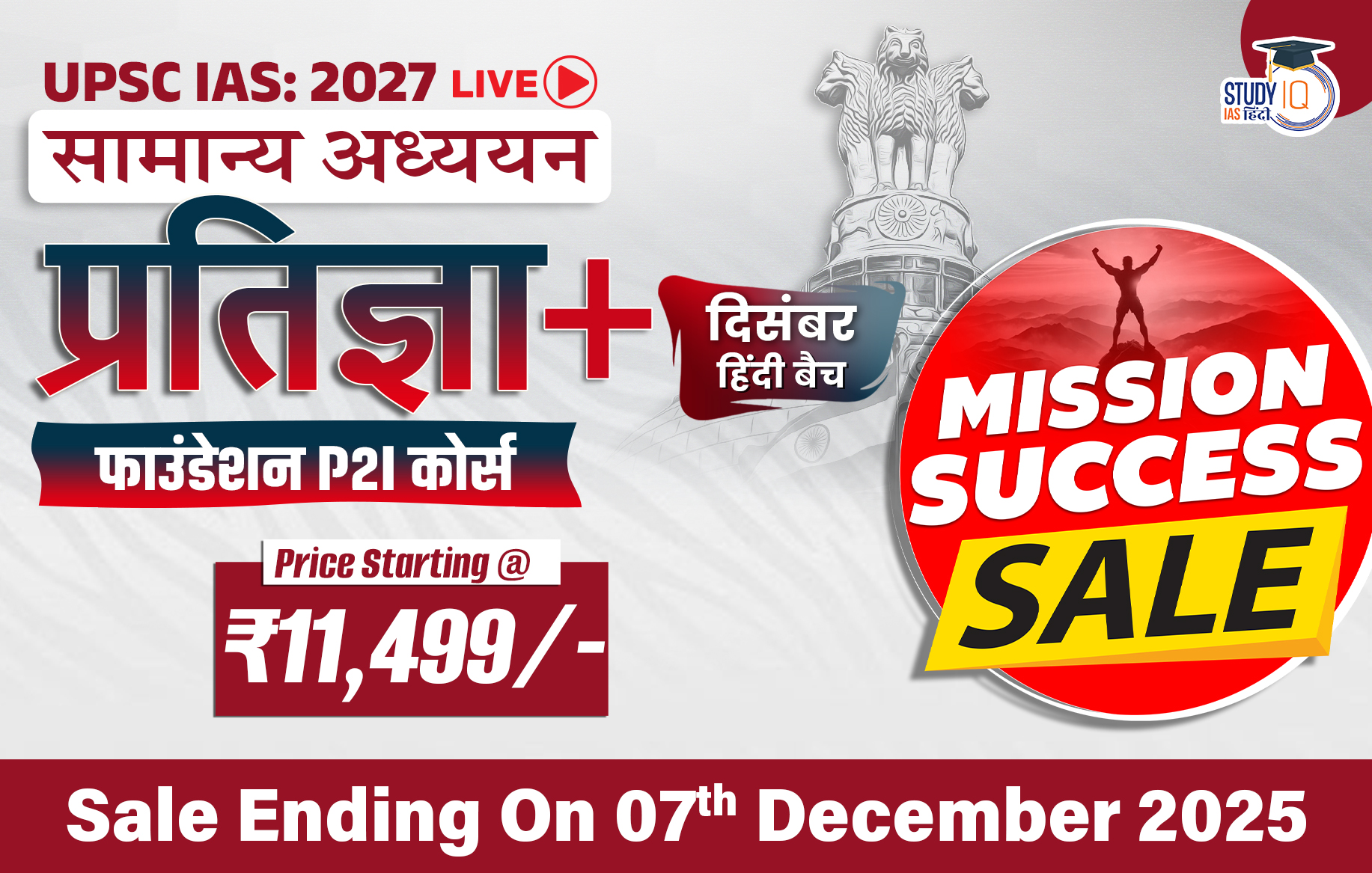Daily Quiz 12 July 2025
Quiz-summary
0 of 5 questions completed
Questions:
- 1
- 2
- 3
- 4
- 5
Information
- Click on – ‘Start Quiz’ button
- Solve Questions
- Click on ‘Next’ button
- Click on ‘Finish Quiz’ button
- Now click on ‘View Questions’ button – here you will see solutions and links.
- The test contains a total of 5 questions.
- Click on the most appropriate option to mark it as your answer.
- You will be awarded Two marks for each correct answer.
- You can change your answer by clicking on some other option.
- A Number list of all questions appears at the top side of the screen.
- You can access the questions in any order by clicking on the question number given on the number list.
- You can use rough sheets while taking the test.
- Do not use calculators, log tables, dictionaries, or any other printed/online reference material during the test.
- Do not click the button “Finish Quiz” before completing the test. A test once submitted cannot be resumed.
You have already completed the quiz before. Hence you can not start it again.
Quiz is loading...
You must sign in or sign up to start the quiz.
You have to finish following quiz, to start this quiz:
- 1
- 2
- 3
- 4
- 5
- Answered
- Review
-
Question 1 of 5
1. Question
1 pointsConsider the following statements:
Statement I: Climate change is displacing India’s coastal communities by undermining their livelihoods and physical habitat.
Statement II: Sea-level rise, saltwater intrusion, and extreme weather events are reducing the viability of agriculture and fishing in coastal areas.
Statement III: India has a dedicated legal framework that fully recognizes and protects the rights of climate-induced migrants.
Which one of the following is correct in respect of the above statements?Correct
Answer: (d)
Explanation:
• Statement Iis correct: Climate change is driving displacement in India’s coastal regions by eroding land, damaging ecosystems, and destroying livelihoods.
• Statement II is correct: Factors like sea-level rise, saltwater intrusion, and frequent cyclones are degrading coastal agricultural and fishing systems, which directly contributes to displacement.
• Statement III is incorrect: India lacks a dedicated legal framework that recognizes or protects climate-induced migrants. Current laws like the Disaster Management Act or CRZ 2019 do not adequately address their social, economic, or legal vulnerabilities.
Statement II clearly explains Statement I by linking climate impacts to displacement.
Statement III is incorrect and does not support Statement I.
Hence, option (d) is correct.Incorrect
Answer: (d)
Explanation:
• Statement Iis correct: Climate change is driving displacement in India’s coastal regions by eroding land, damaging ecosystems, and destroying livelihoods.
• Statement II is correct: Factors like sea-level rise, saltwater intrusion, and frequent cyclones are degrading coastal agricultural and fishing systems, which directly contributes to displacement.
• Statement III is incorrect: India lacks a dedicated legal framework that recognizes or protects climate-induced migrants. Current laws like the Disaster Management Act or CRZ 2019 do not adequately address their social, economic, or legal vulnerabilities.
Statement II clearly explains Statement I by linking climate impacts to displacement.
Statement III is incorrect and does not support Statement I.
Hence, option (d) is correct. -
Question 2 of 5
2. Question
1 pointsConsider the following statements:
Statement I: Rising global military spending can undermine progress towards achieving global development and climate goals.
Statement II: Increased defence budgets divert public resources from essential sectors like health, education, and climate mitigation.
Statement III: Military expenditures contribute to higher carbon emissions, affecting efforts to tackle climate change.
Which one of the following is correct in respect of the above statements?
Correct
Answer: (a)
Explanation:
- Statement I is correct: Rising global military spending, such as NATO’s proposed increase to 5% of GDP by 2035, threatens progress toward Sustainable Development Goals (SDGs) and climate action, as it redirects funds away from critical areas of public welfare and planetary protection.
- Statement II is correct: Military budgets are crowding out development spending. For example, while India allocated over ₹6.8 lakh crore to defence in 2023–24, only ₹7,200 crore went to Ayushman Bharat, a flagship health program. Similarly, foreign aid budgets like USAID are being cut, directly harming global humanitarian and development projects.
- Statement III is also correct: The defence sector is carbon-intensive, and increasing military operations add to greenhouse gas emissions. For instance, NATO’s 3.5% GDP spending target is estimated to produce an additional 200 million tonnes of CO₂ annually, further aggravating the climate crisis.
Statement II explains how essential funds are diverted, reducing developmental capacity.
Statement III explains the environmental consequences of rising defence activity.
Both together justify why rising military spending undermines sustainable development.Hence, option (a) is correct.
Incorrect
Answer: (a)
Explanation:
- Statement I is correct: Rising global military spending, such as NATO’s proposed increase to 5% of GDP by 2035, threatens progress toward Sustainable Development Goals (SDGs) and climate action, as it redirects funds away from critical areas of public welfare and planetary protection.
- Statement II is correct: Military budgets are crowding out development spending. For example, while India allocated over ₹6.8 lakh crore to defence in 2023–24, only ₹7,200 crore went to Ayushman Bharat, a flagship health program. Similarly, foreign aid budgets like USAID are being cut, directly harming global humanitarian and development projects.
- Statement III is also correct: The defence sector is carbon-intensive, and increasing military operations add to greenhouse gas emissions. For instance, NATO’s 3.5% GDP spending target is estimated to produce an additional 200 million tonnes of CO₂ annually, further aggravating the climate crisis.
Statement II explains how essential funds are diverted, reducing developmental capacity.
Statement III explains the environmental consequences of rising defence activity.
Both together justify why rising military spending undermines sustainable development.Hence, option (a) is correct.
-
Question 3 of 5
3. Question
1 pointsWhich of the following correctly explains the objective of the WHO’s “3 by 35” initiative?
Correct
Answer: (b)
Explanation:
- The “3 by 35” initiative launched by WHO calls for a minimum 50% increase in the real prices of tobacco, alcohol, and sugary drinks by 2035, achieved through health taxes.
- Purpose: To tackle the global rise of non-communicable diseases (NCDs) such as heart disease, diabetes, and cancer, which now account for over 75% of global deaths.
- Additional goals include generating domestic revenue, reducing external aid dependence, and promoting fiscal and public health synergy.
The campaign targets an ambitious $1 trillion in global revenue over the next decade, with a projected saving of 50 million lives over 50 years.
Incorrect
Answer: (b)
Explanation:
- The “3 by 35” initiative launched by WHO calls for a minimum 50% increase in the real prices of tobacco, alcohol, and sugary drinks by 2035, achieved through health taxes.
- Purpose: To tackle the global rise of non-communicable diseases (NCDs) such as heart disease, diabetes, and cancer, which now account for over 75% of global deaths.
- Additional goals include generating domestic revenue, reducing external aid dependence, and promoting fiscal and public health synergy.
The campaign targets an ambitious $1 trillion in global revenue over the next decade, with a projected saving of 50 million lives over 50 years.
-
Question 4 of 5
4. Question
1 pointsWhich of the following correctly identifies a unique feature of Ham Radio (Amateur Radio)?
Correct
Answer: (c)
Explanation:
- Ham Radio, also called amateur radio, is a licensed, non-commercial radio communication service used for personal learning, public service, and emergency communication.
- It does not depend on cellular or internet networks, making it extremely valuable during disasters such as the Bhuj Earthquake (2001), Indian Ocean Tsunami (2004), and Uttarakhand floods (2013).
- In July 2025, Indian astronaut ShubhanshuShukla used ham radio from the ISS to communicate with Indian students — showing its space-based application.
Anyone over 12 years of age in India can obtain a ham radio license from MeitY.
Incorrect
Answer: (c)
Explanation:
- Ham Radio, also called amateur radio, is a licensed, non-commercial radio communication service used for personal learning, public service, and emergency communication.
- It does not depend on cellular or internet networks, making it extremely valuable during disasters such as the Bhuj Earthquake (2001), Indian Ocean Tsunami (2004), and Uttarakhand floods (2013).
- In July 2025, Indian astronaut ShubhanshuShukla used ham radio from the ISS to communicate with Indian students — showing its space-based application.
Anyone over 12 years of age in India can obtain a ham radio license from MeitY.
-
Question 5 of 5
5. Question
1 pointsConsider the following pairs:
Scheme/App Objective A. Surya Ghar: MuftBijliYojana 1. Provides rooftop solar subsidy for households – 300 units/month. B. RailOne App 2. Integrates all railway services (IRCTC, UTS, NTES) into one platform. C. PM-KUSUM 3. Aims to solarize irrigation pumps and promote solar in agriculture. How many of the pairs given above are incorrectly matched?
Correct
Answer: (d)
Explanation:
A – 1: Surya Ghar: MuftBijliYojana
- Launched by: Government of India (2024).
- Objective: Promote adoption of rooftop solar by common households.
- Key Features:
- Households receive free 300 units/month of electricity through solar generation.
- Provides a central subsidy of up to ₹78,000 for rooftop installations.
- Targets 1 crore households, focusing on energy sustainability and reducing power bills.
- Helps India meet its renewable energy targets under the National Solar Mission.
- Impact: Empowers citizens to become prosumers (producers + consumers), reduces carbon footprint, and enhances energy self-reliance.
B – 2: RailOne App
- Launched by: Indian Railways in 2024–25.
- Objective: Offer a single unified digital platform integrating multiple railway services.
- Key Features:
- Combines features of IRCTC Rail Connect, UTSonMobile, NTES, Rail Madad, Food on Track, etc.
- Enables ticket booking, PNR inquiry, live train tracking, onboard catering, complaint redressal, and more.
- Provides clean user interface, biometric/mPIN login, and wallet integration.
- Significance: Improves commuter experience, reduces app redundancy, and enhances ease of travel in a digital India ecosystem.
C – 3: PM-KUSUM (PradhanMantriKisanUrjaSurakshaevamUtthaanMahabhiyan)
- Launched: 2019 (still ongoing).
- Objective: Promote solar energy use in agriculture, especially irrigation.
- Key Components:
- Component A: Setting up of decentralized solar plants on barren land.
- Component B:Standalone solar pumps for irrigation.
- Component C:Solarization of existing grid-connected agricultural pumps.
- Incentives: Up to 60% subsidy, 30% loan, and 10% farmer contribution.
- Impact: Reduces dependence on diesel, promotes clean energy, boosts farmer income by enabling surplus power sale.
Each of these schemes/apps reflects India’s focus on clean energy (Surya Ghar, PM-KUSUM) and digital governance (RailOne App) to improve citizen welfare, agricultural productivity, and infrastructure efficiency.
Incorrect
Answer: (d)
Explanation:
A – 1: Surya Ghar: MuftBijliYojana
- Launched by: Government of India (2024).
- Objective: Promote adoption of rooftop solar by common households.
- Key Features:
- Households receive free 300 units/month of electricity through solar generation.
- Provides a central subsidy of up to ₹78,000 for rooftop installations.
- Targets 1 crore households, focusing on energy sustainability and reducing power bills.
- Helps India meet its renewable energy targets under the National Solar Mission.
- Impact: Empowers citizens to become prosumers (producers + consumers), reduces carbon footprint, and enhances energy self-reliance.
B – 2: RailOne App
- Launched by: Indian Railways in 2024–25.
- Objective: Offer a single unified digital platform integrating multiple railway services.
- Key Features:
- Combines features of IRCTC Rail Connect, UTSonMobile, NTES, Rail Madad, Food on Track, etc.
- Enables ticket booking, PNR inquiry, live train tracking, onboard catering, complaint redressal, and more.
- Provides clean user interface, biometric/mPIN login, and wallet integration.
- Significance: Improves commuter experience, reduces app redundancy, and enhances ease of travel in a digital India ecosystem.
C – 3: PM-KUSUM (PradhanMantriKisanUrjaSurakshaevamUtthaanMahabhiyan)
- Launched: 2019 (still ongoing).
- Objective: Promote solar energy use in agriculture, especially irrigation.
- Key Components:
- Component A: Setting up of decentralized solar plants on barren land.
- Component B:Standalone solar pumps for irrigation.
- Component C:Solarization of existing grid-connected agricultural pumps.
- Incentives: Up to 60% subsidy, 30% loan, and 10% farmer contribution.
- Impact: Reduces dependence on diesel, promotes clean energy, boosts farmer income by enabling surplus power sale.
Each of these schemes/apps reflects India’s focus on clean energy (Surya Ghar, PM-KUSUM) and digital governance (RailOne App) to improve citizen welfare, agricultural productivity, and infrastructure efficiency.
Results
0 of 5 questions answered correctly
Your time:
Time has elapsed
You have reached 0 of 0 points, (0)
| Average score |
|
| Your score |
|
Categories
- Not categorized 0%
| Pos. | Name | Entered on | Points | Result |
|---|---|---|---|---|
| Table is loading | ||||
| No data available | ||||
Sharing is caring!


 Daily Quiz 18 September 2025
Daily Quiz 18 September 2025

























